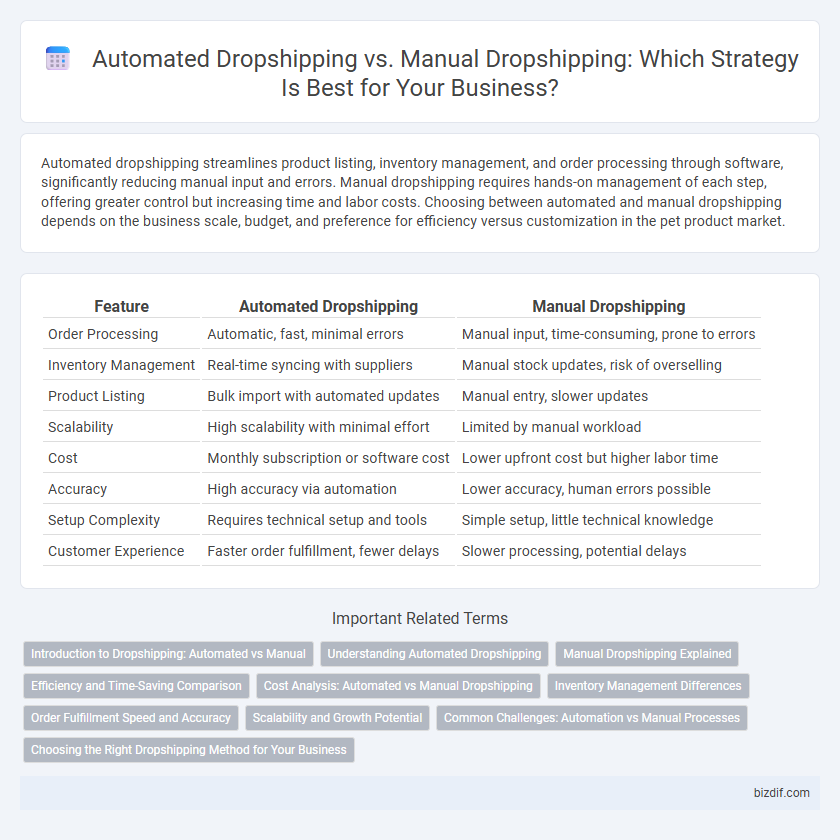Automated dropshipping streamlines product listing, inventory management, and order processing through software, significantly reducing manual input and errors. Manual dropshipping requires hands-on management of each step, offering greater control but increasing time and labor costs. Choosing between automated and manual dropshipping depends on the business scale, budget, and preference for efficiency versus customization in the pet product market.
Table of Comparison
| Feature | Automated Dropshipping | Manual Dropshipping |
|---|---|---|
| Order Processing | Automatic, fast, minimal errors | Manual input, time-consuming, prone to errors |
| Inventory Management | Real-time syncing with suppliers | Manual stock updates, risk of overselling |
| Product Listing | Bulk import with automated updates | Manual entry, slower updates |
| Scalability | High scalability with minimal effort | Limited by manual workload |
| Cost | Monthly subscription or software cost | Lower upfront cost but higher labor time |
| Accuracy | High accuracy via automation | Lower accuracy, human errors possible |
| Setup Complexity | Requires technical setup and tools | Simple setup, little technical knowledge |
| Customer Experience | Faster order fulfillment, fewer delays | Slower processing, potential delays |
Introduction to Dropshipping: Automated vs Manual
Automated dropshipping uses software and tools to streamline product sourcing, inventory management, and order fulfillment, reducing manual workload and minimizing errors. Manual dropshipping requires hands-on management of supplier communications, order placements, and customer service, offering more control but consuming significant time. Choosing between automated and manual dropshipping depends on business scale, budget, and desired efficiency in managing eCommerce operations.
Understanding Automated Dropshipping
Automated dropshipping leverages software tools to streamline product listing, inventory management, and order fulfillment, significantly reducing manual workload and human error. By integrating APIs and automated systems, it enables real-time updates on stock levels and pricing, enhancing efficiency and scalability for online stores. Understanding automated dropshipping is crucial for entrepreneurs aiming to optimize operations, improve customer experience, and compete effectively in fast-paced e-commerce markets.
Manual Dropshipping Explained
Manual dropshipping involves handling product orders, inventory tracking, and supplier communication without automation tools, providing full control over each transaction process. This approach demands significant time investment and attention to detail but allows customization and flexibility in managing supplier relationships and order fulfillment. Entrepreneurs using manual dropshipping often prioritize personalized customer service and direct oversight, which can lead to higher quality control and tailored business strategies.
Efficiency and Time-Saving Comparison
Automated dropshipping streamlines order processing and inventory management using software tools, significantly reducing manual effort and minimizing errors. Manual dropshipping requires hands-on management of product listings, order fulfillment, and customer service, often leading to longer processing times and higher chances of mistakes. Efficiency gains in automated dropshipping enable faster scalability and improved time savings compared to the labor-intensive nature of manual dropshipping operations.
Cost Analysis: Automated vs Manual Dropshipping
Automated dropshipping reduces long-term operational costs by minimizing manual labor through software tools that streamline order processing and inventory management, leading to fewer errors and faster fulfillment. Manual dropshipping requires continuous hands-on management, increasing labor expenses and the risk of mistakes that can result in costly order delays or returns. Investing in automation tools might involve higher upfront costs but offers significant savings and scalability benefits compared to the ongoing higher time and resource expenditure seen in manual dropshipping workflows.
Inventory Management Differences
Automated dropshipping leverages real-time inventory management software, enabling seamless stock updates, reducing human error, and preventing overselling across multiple sales channels. Manual dropshipping relies on frequent, manual stock checks and order confirmations, which increases the risk of inventory discrepancies and delays in order fulfillment. Efficient inventory synchronization in automated systems enhances scalability and customer satisfaction, making it essential for high-volume dropshipping businesses.
Order Fulfillment Speed and Accuracy
Automated dropshipping significantly enhances order fulfillment speed by using software to process orders instantly and communicate directly with suppliers, reducing delays and human errors. Manual dropshipping relies on manual input and communication, which can slow down the fulfillment process and increase the likelihood of inaccuracies such as incorrect item details or shipping errors. Businesses using automated systems benefit from real-time inventory updates and automatic tracking integration, leading to higher fulfillment accuracy and improved customer satisfaction.
Scalability and Growth Potential
Automated dropshipping leverages software to streamline order processing, inventory management, and customer communication, enabling businesses to scale rapidly with minimal manual intervention. Manual dropshipping requires hands-on management of each transaction, limiting the volume of orders that can be efficiently handled and constraining growth potential. The scalability of automated systems supports higher order throughput and faster market expansion, making it ideal for entrepreneurs aiming for substantial growth in competitive e-commerce landscapes.
Common Challenges: Automation vs Manual Processes
Automated dropshipping streamlines order processing and inventory management but often faces challenges with software integration and occasional system errors. Manual dropshipping allows for personalized control and flexibility but increases the risk of human error, slower order fulfillment, and difficulty in scaling operations. Balancing automation benefits with manual oversight is essential to minimize issues like stock discrepancies and fulfillment delays in dropshipping businesses.
Choosing the Right Dropshipping Method for Your Business
Automated dropshipping streamlines order processing and inventory management through software integration, minimizing errors and saving time. Manual dropshipping offers greater control over product selection and customer service, but requires significant hands-on effort and increased risk of mistakes. Evaluating your business size, technical skills, and growth goals is essential to choose between the efficiency of automation and the personalized approach of manual management.
Automated Dropshipping vs Manual Dropshipping Infographic

 bizdif.com
bizdif.com